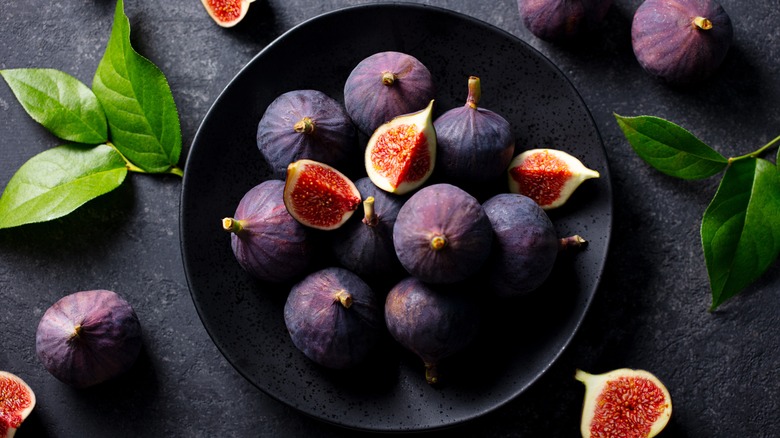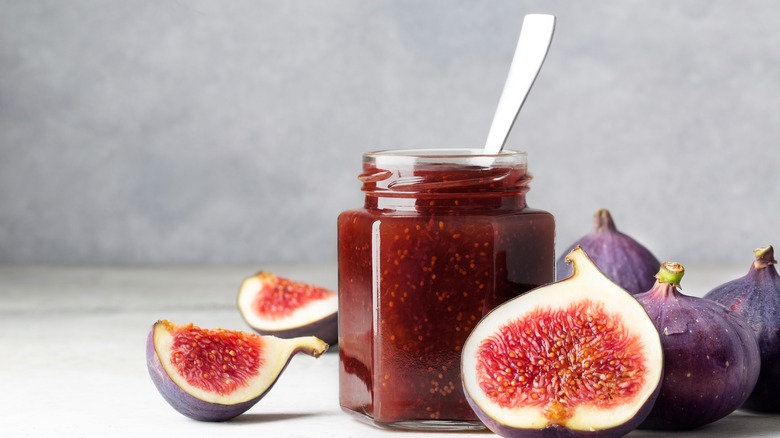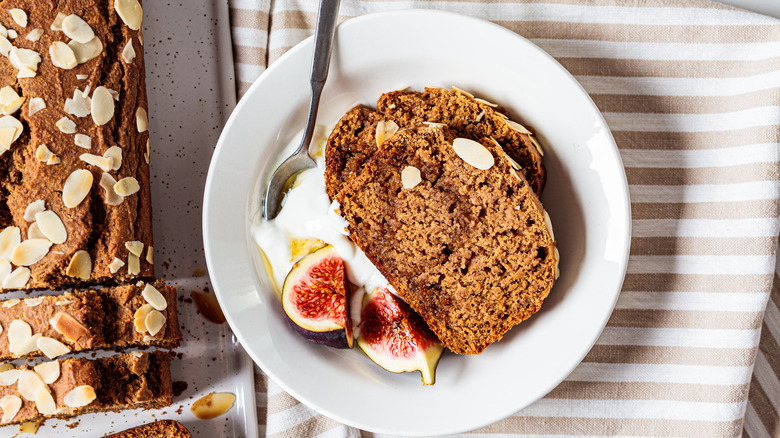What To Do With Overripe Figs
Dried figs are super accessible, but fresh figs — not so much. Their short seasonal window can make tracking down the teardrop-shaped fruits a bit of a challenge. Yet, stocking up when they're in season can also pose a problem given their short shelf life. Should you find yourself with a stockpile of overripe figs, rather than toss them into the compost bin, here's what you can do instead.
Whether you're a fan of a fruity Black Mission, nutty Calimyrna, or honeyed Sierra, choosing unbruised and unblemished fruit is key to avoiding immediate spoilage. While figs are best enjoyed very soon after purchase, they can be kept in the crisper drawer of the fridge for up to seven days or until they begin to go moldy. The question is, what causes such rapid spoilage?
An evolutionary response to promote seed spreading, the starches in the fruit break down and cause sugar levels to increase and aromas to intensify with the passage of time. Since delicate figs are picked when they're already ripe, the longer they rest, they'll eventually start oozing syrup from their base, indicating that there's no sweeter time than the present to enjoy them. However, if you notice your figs have begun to drip and wrinkle excessively, it's time to repurpose them.
Cook overripe figs for a jammy flavor explosion
Fresh figs are a treat that can be enjoyed on their own, as cutting into the soft and seedy fruit reveals a gorgeous, rosy interior bursting with molasses-y, berry-forward flavors. But if your figs are overripe and looking worse for the wear, you can still cook them. A wrinkled skin says little of the edibility of the sweet flesh, whose natural sweetness will become instantly amplified as stews in its juices and caramelizes.
Jams, sauces, and syrups are always a good way to use overripe fruit, though the options are endless. Whether you roast, simmer, or poach the fruits, figs are great for topping ice cream, layering into trifles, serving over cheesecake, or swirling into popsicles. Cooked figs can be a great companion to savory ingredients, as well. Whether left delicately sweet or transformed into a punchy fig mustard, overripe fruits meet their match with anything from salty prosciutto to tangy labneh.
And if you aren't quite ready to experiment with fig recipes, freeze the sweet morsels for a later date. After washing and drying, you can place whole figs on a lined baking sheet to freeze or quarter them and combine them with some sugar before freezing in an airtight container.
When in doubt, bake overripe figs
If the prospect of standing over a bubbling pot, waiting for fresh (albeit overripe) or frozen figs to soften doesn't appeal to you, then we've got one more suggestion. Rather than cook them down, try baking with the figs. You could whip up a batch of figgy brownies, bars, cookies, a pudding, or something more delicate like a gorgeous fig and raspberry galette. However, the easiest way to use up less-than-aesthetic fruits is to make fig bread.
Following the formula for a quick bread, fig bread requires no yeast or time spent proofing. Instead, a leavening agent helps the loaf to rise as it bakes, which saves you loads of time and effort. While recipes may vary, making fig bread is basically a matter of folding dry ingredients (flour, sugar, salt, and baking soda or baking powder) into wet ingredients (eggs, milk, oil or butter, and mashed figs) and baking at 350 degrees Fahrenheit for just under an hour. When honeyed aromas begin to fill the kitchen, the bread is ready.
Using overripe figs helps highlight the fruit's most nuanced flavors and adds to the baked good's richness without being cloyingly sweet. Enjoy the sweet, dense loaf on its own, or jazz it up with a dollop of whipped cream — there's no wrong way to eat fig bread. And whether you simmer, roast, or bake, when it comes to transforming those tired old figs, the choice is yours!


